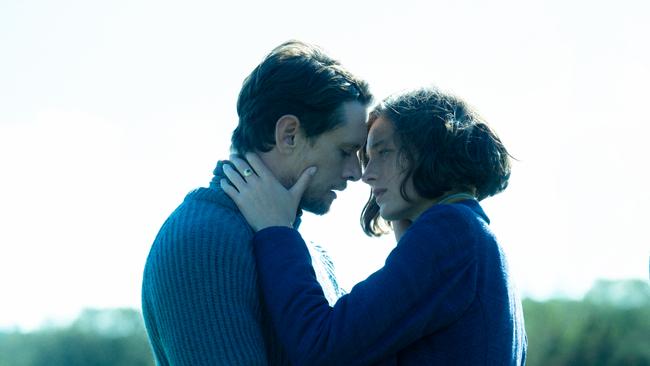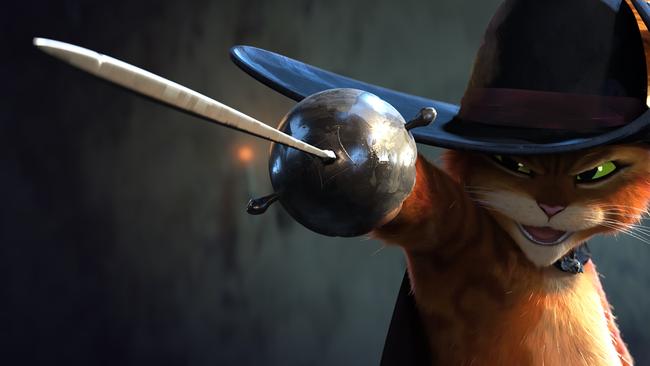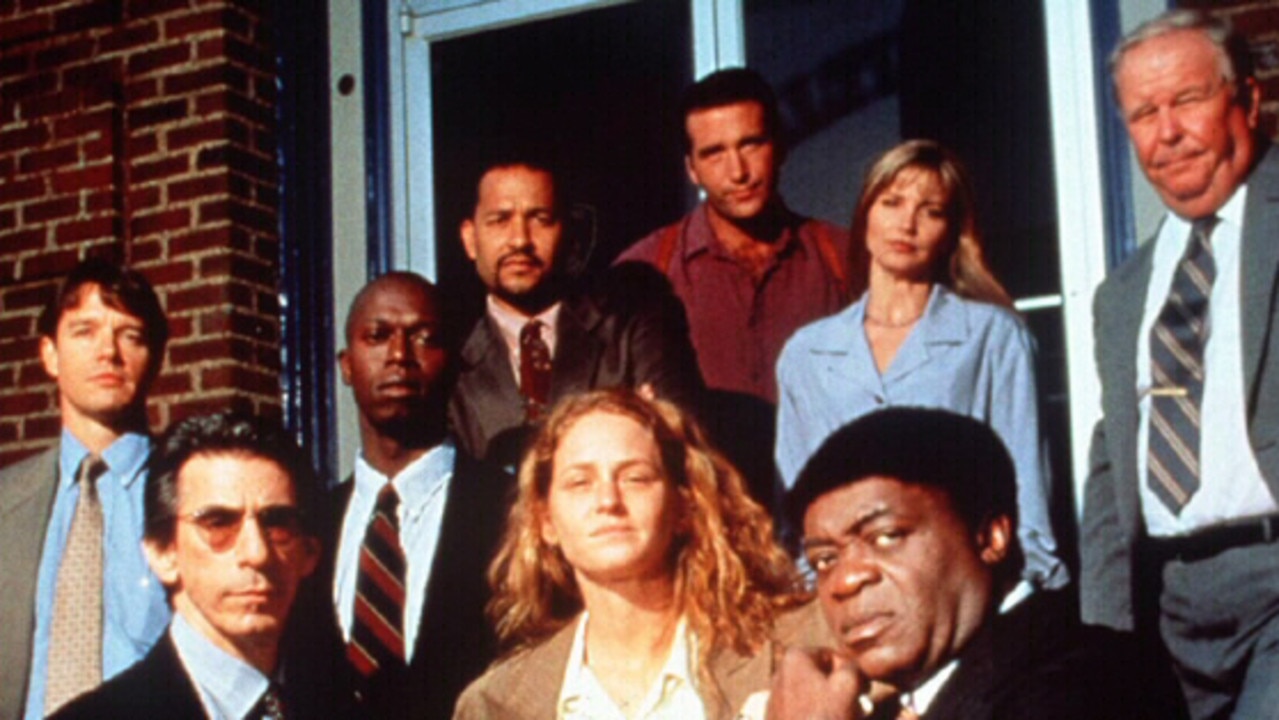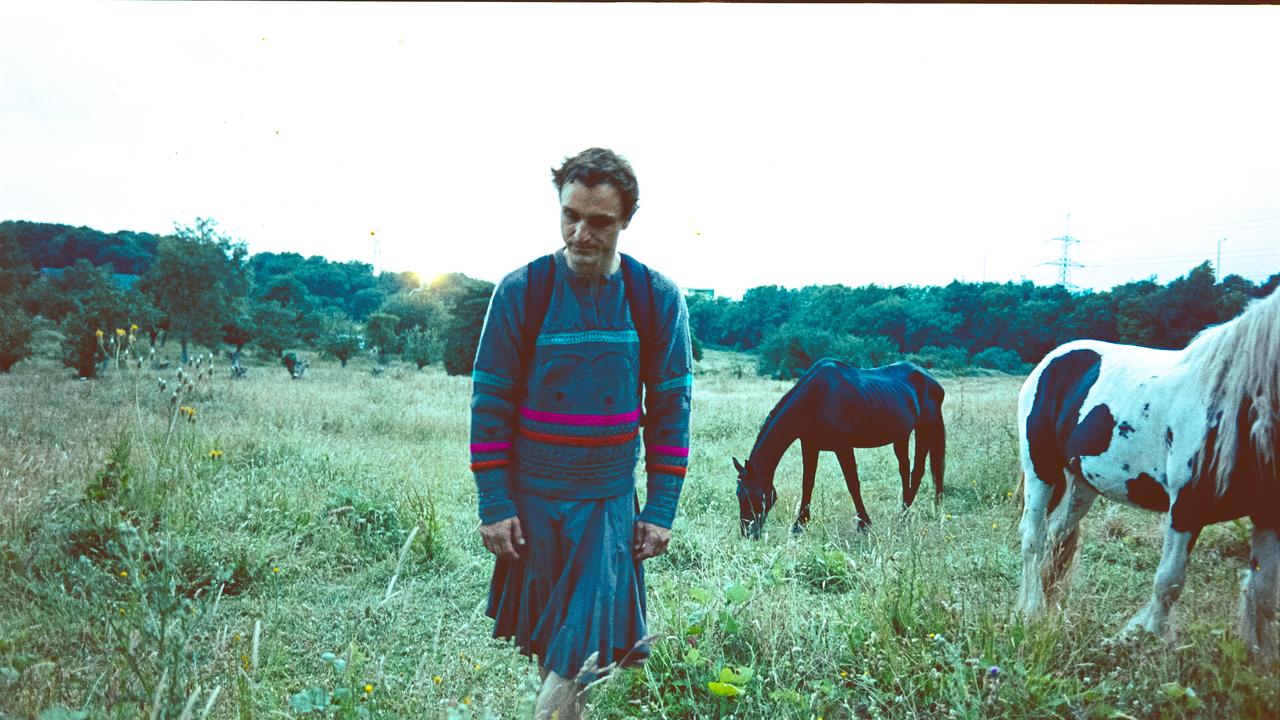Lady Chatterley’s Lover, banned novel’s thrilling affair
“Are you afraid?” she asks him when the affair is in full swing. “I bloody well am,” he admits.

Lady Chatterley’s Lover (MA15+)
In cinemas
★★★½
The first time Lady Chatterley (Emma Corrin) meets the ruggedly handsome gamekeeper Oliver Mellors (Jack O’Connell) he has a shotgun slung over an arm and a dog by his side.
The second time he flexes some muscle to help her push her wheelchair-bound husband, Sir Clifford Chatterley (Matthew Duckett), through a muddy field.
The third time she spots him standing naked under an outdoor shower at his cottage. She looks on and smiles. Soon after she is inside the cottage and notices he has James Joyce on the bookshelf.
You don’t have to have read DH Lawrence’s much-banned 1928 novel to see where this is heading. “You don’t want to be a lady?” the gamekeeper asks after she asks him not to call her “m’lady”. “Not with you,’’ she replies.
The challenge for a filmmaker is to make this affair, which breaks marriage vows and, more importantly, class distinctions, still salacious in the post-Fifty Shades of Grey era.
French actor turned director Laure de Clermont-Tonnere does so with panache in Lady Chatterley’s Lover, the latest adaptation of Lawrence’s much-adapted novel.
As an aside, it’s interesting that this is the fourth film version by a French filmmaker. Perhaps, when it comes to Lady C and the gamekeeper, they have their compatriot poet Paul Valery in mind: “Love is to be stupid together.’’
It’s the thrilling kind of stupid. Dramatic, desperate and dangerous. “Are you afraid?” she asks him when the affair is in full swing. “I bloody well am,” he admits.
Corrin, aka the young Princess Di in The Crown, and O’Connell bring blistering intensity to this story of mismatched lovers. The sex scenes are raunchy, including one that is not in the novel. I think Lawrence would be impressed.
The erotic encounters, especially the alfresco ones, must have been a challenge for the actors, and for French cinematographer Benoit Delhomme, who has worked with Australia’s John Hillcoat (The Proposition, Lawless). They do them well, blending arcadian art with primal lust.
Kudos, too, to British costume designer Emma Fryer. When Lady C, swathed in a bright red dress, walks through the lush green English midlands to meet the gamekeeper, the colours say all that needs to be said.
This 127-minute movie opens with Constance Reid, “a woman from well-to-do intelligentsia”, as Lawrence calls her, exchanging wedding vows with minor aristocrat Clifford Chatterley.
It’s the “in sickness and health” bit that becomes a problem after Sir Clifford, at the front in World War I, is paralysed from the waist down.
There’s a telling scene where they are in bed together and she guides his hand towards her genital area. Not only is he having none of that but he expects her to be his full-time carer at his vast estate.
One of these problems is solved when Mrs Bolton (Joely Richardson, who was Lady Chatterley in a 1993 BBC drama), is hired to look after Sir Clifford. The other is solved when Lady C meets the gamekeeper.
This thoughtful film, scripted by Oscar-nominee David Magee (Finding Neverland, Life of Pi), touches on other themes explored in the novel, such as post-war trauma and the advance of industrialisation (Sir Clifford owns a colliery; Lawrence’s father was a miner).
The director does makes some changes, both to character and plot, particularly at the end. Again, I don’t think Lawrence, who died aged 44 not long after Lady Chatterley’s was published, would complain. He wrote three versions of this novel and who’s to say he would not have tinkered with it further.
Lawrence’s driving theme was that love must involve body and mind, and the director understands that. It’s Joely Richardson, once Lady Chatterley, now Mrs Bolton, who sums it up. “This,’’ she gently reprimands the other gossiping servants, “is a love story.”
Puss in Boots: The Last Wish (PG)
In cinemas. Sneak previews this weekend; general release from Christmas Day
★★★
The most interesting, and funniest, characters in the Dreamworks animated children’s movie Puss in Boots: The Last Wish are the baddies. They’re the sort of reprobates the star, Antonio Banderas, who voices the titular Puss, might relish playing in the flesh.
There’s Big Jack Horner (voiced by comedian John Mulaney), the despotic ruler of a pie-making empire. His avaricious adult self stems from his underprivileged childhood, starting with the fact he was conceived in a mere nursery rhyme rather than a full fairytale.
There’s an intimidating wolf (Brazilian actor Wagner Moura) who is introduced as a bounty hunter but who adult viewers will suspect is a lupine Grim Reaper. The scythes he carries are a bit of a giveaway. Both Big Jack Horner and el lobo are in pursuit of the legendary (by his own account) swordsman Puss in Boots (Banderas) but for different reasons. One wants to take what he might wish for, the other wants to take his life.
This 100-minute movie, directed by Dreamworks regular Joel Crawford, is a sequel to Puss in Boots (2011). As the subtitle suggests, it’s centred on a last wish.
The action opens with Puss doing what he does: swinging his sword and singing a song. He awakes a sleeping giant and what happens suggests a downside to Puss’s motto of laughing in the face of death.
He comes to rooms of the village doctor, who asks him how many times he has died. As Puss remembers his deaths, which include the truth that cats don’t always land on their feet, it emerges he is on the last of his nine lives.
This recall of past demises is humorous, as is what happens when Puss, now a bit of a scaredy cat, retires to a home run by a cat lady (Da’Vine Joy Randolph).
He grows a beard, queues for the litter box and sort of befriends a dog disguised as a cat (Harvey Gullien), who proves, and I admit bias here, that dogs are the best. This quiet if dull life changes when Goldilocks and the three bears (British actors Florence Pugh, Olivia Colman, Ray Winstone and Samson Kayo), burst into the house singing English ditties.
At the same time, Puss’s on-and-off love interest, Kitty Softpaws (Salma Hayek), comes onto the scene. She tells him his beard is disgusting.
In short, there is a map that, if possessed, will grant its owner one wish. The map is to a dark forest with landmarks such as the Mountains of Misery, and most of the action unfolds there.
Puss wants the map so he can wish for more lives. Kitty Softpaws, Big Jack Horner and Goldilocks, leader of the ursine crime family, want it for different reasons. The wolf wants something else. The dog, the one character who truly cares for others, goes along because he’s a good boy.
This is an entertaining movie that asks a question all viewers might pause to think about: if you had just one wish, what would it be, and who would it be for, yourself or someone else?




